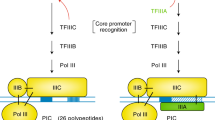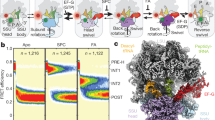Abstract
The defining property of G binding proteins is their ability to bind guanine nucleotides, and in this review we shall concentrate upon the domain or subunit responsible for carrying out this function. A common function of such a general nature, exercised in so many different biological organisms and biochemical contexts, does not automatically imply a high, or even a detectable, degree of homology among the proteins that proffer it. The G-proteins provide a spectrum of degrees of kinship that range from the intimate to the unrecognisable. Satisfyingly, this spectrum correlates largely with similarity of function, at least within the general classes of G-proteins. Nevertheless, among these classes it remains a matter for conjecture whether the difference between just detectable homology and no detectable homology, significant as it may be in the statistical sense, is significant in the subjective sense of “telling us anything about evolution.”
This is a preview of subscription content, access via your institution
Access options
Subscribe to this journal
Receive 12 print issues and online access
$209.00 per year
only $17.42 per issue
Buy this article
- Purchase on Springer Link
- Instant access to full article PDF
Prices may be subject to local taxes which are calculated during checkout
Similar content being viewed by others
References
Clark, B.F.C., Jensen, M., Kjeldgård and Thirup, S. 1989. Structural homologies in G-binding proteins. In: Annual Smith, Kline and French Research Symposium “Protein Design and the Development of New Therapeutics and Vaccines”.
Clark, B. 1980. The elongation step of protein biosynthesis. Trends Biochem. Sci. 5:207–210.
la Cour, T.F.M., Nyborg, J., Thirup, S. and Clark, B.F.C. 1985. Structural details of the binding of guanosine diphosphate to elongation factor Tu from E.coli as studied by X-ray crystallography. EMBO J. 4:2385–2388.
Jurnak, F. 1985. Structure of the GDP domain of EF-Tu and location of the amino acids homologous to ras oncogene proteins. Science 230:32–36.
Nyborg, J. and la Cour, T.F.M. 1989. New structural data on elongation factor-Tu: GDP based on X-ray crystallography. In: The Guanine-Nucleotide Binding Proteins. Common Structural and Functional Properties EMBO/NATO/CEC Adv. Res. Workshop, Renesse, The Netherlands, Aug. 1988. L. Bosch, B. Kraal and A. Parmeggiani (Eds.). Plenum Press, NY.
Parmeggiani, A, Swart, G.W.M., Mortensen, K.K., Jensen, M., Clark, B.F.C., Dente, L. and Cortese, R. 1987. Properties of a genetically engineered G domain of elongation factor Tu. Proc. Natl. Acad. Sci. USA 84:3141–3145.
Hwang, Y.-W. and Miller, D.L. 1987. A mutation that alters the nucleotide specificity of elongation factor Tu, a GTP-regulatory protein. J. Biol. Chem. 262:13081–13085.
Dever, T.E., Glynias, M.J. and Merrick, W.C. 1987. GTP-binding domain: Three consensus sequence elements with distinct spacing. Proc. Nad. Acad. Sci. USA 84:1814–1818.
Barbacid, M. 1987. rasGenes. Ann. Rev. Biochem. 56:779–827.
de Vos, A.M., Tong, L., Milburn, M.V., Matias, P.M., Jancarik, J., Noguchi, S., Nishimura, S., Miura, K., Ohtsuka, E. and Kim, S.-H. 1988. Three-dimensional structure of an oncogene protein: Catalytic domain of human c-H-ras p21. Science 239:888–891.
McCormick, F., Clark, B.F.C., la Cour, T.F.M., Kjeldgaard, M., Nørskov-Lauritsen, L. and Nyborg, J. 1985. A model for the tertiary structure of p21, the product of the ras oncogene. Science 230:78–82.
Jurnak, F.A. 1988. The three-dimensional structure of c-H-ras p21: Implications for oncogene and G protein studies. Trends Biocnem.Sci. 13:195–198.
Tong, L., de Vos, A.M., Milburn, M.V., Jancarik, J., Noguchi, S., Nishimura, S., Miura, K., Ohtsuka, E. and Kim, S.-H. 1989. Structural differences between a as oncogene protein and the normal protein. Nature 337:90–93.
Jacquet, E. and Parmeggiani, A. 1988. Structure-function relationships in the GTP binding domain of EF-Tu: Mutation of Val20, the residue homologous to position 12 in p21. EMBO J. 7:2861–2867.
Jensen, M., Cool, R.H., Mortensen, K.K., Clark, B.F.C. and Parmeggiani, A. 1989. Structure-function relationships of elongation factor Tu.Isolation and activity of the guanine nucleotide binding domain. Eur. J. Biochem. In press.
Halliday, K.R. 1984. Regional homology in GTP-binding proto-oncogene products and elongation factors. J. Cyclic Nucleotide Prot. Phosphoryl. Res. 9:435–448.
Leberman, R. and Egner, U. 1984. Homologies in the primary structure of GTP-binding proteins: The nucleotide-binding site of EF-Tu and p21. EMBO J. 3:339–341.
Möller, W. and Amons, R. 1985. Phosphate-binding sequences in nucleotide-binding proteins. FEBS Lett. 186:1–7.
Dever, T.E. and Merrick, W.C. 1989. The GTP-binding domain revisited, In: The Guanine-Nucleotide binding Proteins.Common Structural and Functional Properties. EMBO/NATO/CEC Adv.Res. Workshop, Renesse, The Netherlands, Aug. 1988. L. Bosch, B. Kraal and A. Parmeggiani (Eds.). Plenum Press, NY.
Cenatiempo, Y., Deville, F., Dondon, J., Grunberg-Manago, M., Sacer-dot, C., Hershey, J.W.B., Hansen, H.F., Petersen, H.U., Clark, B.F.C., Kjeldgaard, M., la Cour, T.F.M., Mortensen, K.K. and Nyborg, J. 1987. The protein synthesis initiation factor 2 G-domain. Study of a functionally active C-terminal 65-kilodalton fragment of IF2 from Escherichia coli Biochem. 26:5070–5076.
March, P.E. and Inouye, M. 1985. GTP-binding membrane protein of scherichia coliwith sequence homology to initiation factor 2 and elongation factors Tu and G. Proc. Natl. Acad. Sci. USA 82:7500–7504.
Toda, T., Uno, I., Ishikawa, T., Powers, S., Kataoka, T., Broek, D., Cameron, S., Broach, J., Matsumoto, K. and Wigler, M. 1985. In yeast, rasproteins are controlling elements of adenylate cyclase. Cell 40:27–36.
Haubruck, H., Disela, C., Wagner, P. and Gallwitz, D. 1987. The ras-related yptprotein is a ubiquitous eucaryotic protein: Isolation and sequence analysis of mouse cDNA clones highly homologous to the yeast YPT1gene. EMBO J. 6:4049–4053.
Chardin, P. and Tavitian, A. 1986. The ralgene: A new rasrelated gene isolated by the use of a synthetic probe. EMBO J. 5:2203–2208.
Gilman, A.G. 1987. G proteins: Transducers of receptor-generated signals. Ann. Rev. Biochem. 56:615–649.
Rawis, R.L. 1987. G-proteins: Research unravels their role in cell communication. Chem. Eng. News., Dec.21:26–39.
Mandelkow, E.-M., Hermann, M. and Rühl, U. 1985. Tubulin domains probed by limited proteolysis and subunit-specific antibodies. J. Mol. Biol. 185:311–327.
Gamier, J., Osguthorpe, D.J. and Robson, B. 1978. Analysis of the accuracy and implications of simple methods for predicting the secondary structure of globular proteins. J. Mol. Biol. 120:97–120.
Bohr, H., Bohr, J., Brunak, S., Cotterill, R.M.J., Lautrup, B., Nørskov, L., Olesen, O. and Petersen, S.B. 1988. Protein secondary structure and homology by neural networks: The α-helices in rhodopsin. FEBS Lett. 241:223–228.
Masters, S.B., Stroud, R.M. and Bourne, H.R. 1986. Family of G protein α chains: Amphipathic analysis and predicted structure of functional domains. Prot. Eng. 1:47–54.
Guy, B., Kieny, M.P., Riviere, Y., Le Peuch, C., Dott, K., Girard, M., Montagnier, L. and Lecocq, J.-P. 1987. HIV F/3′ orfencodes a phosphorylated GTP-binding protein resembling an oncogene product. Nature 330:266–269.
Author information
Authors and Affiliations
Rights and permissions
About this article
Cite this article
Woolley, P., Clark, B. Homologies in the Structures of G-Binding Proteins: An Analysis Based on Elongation Factor EF-TU. Nat Biotechnol 7, 913–920 (1989). https://doi.org/10.1038/nbt0989-913
Issue Date:
DOI: https://doi.org/10.1038/nbt0989-913



